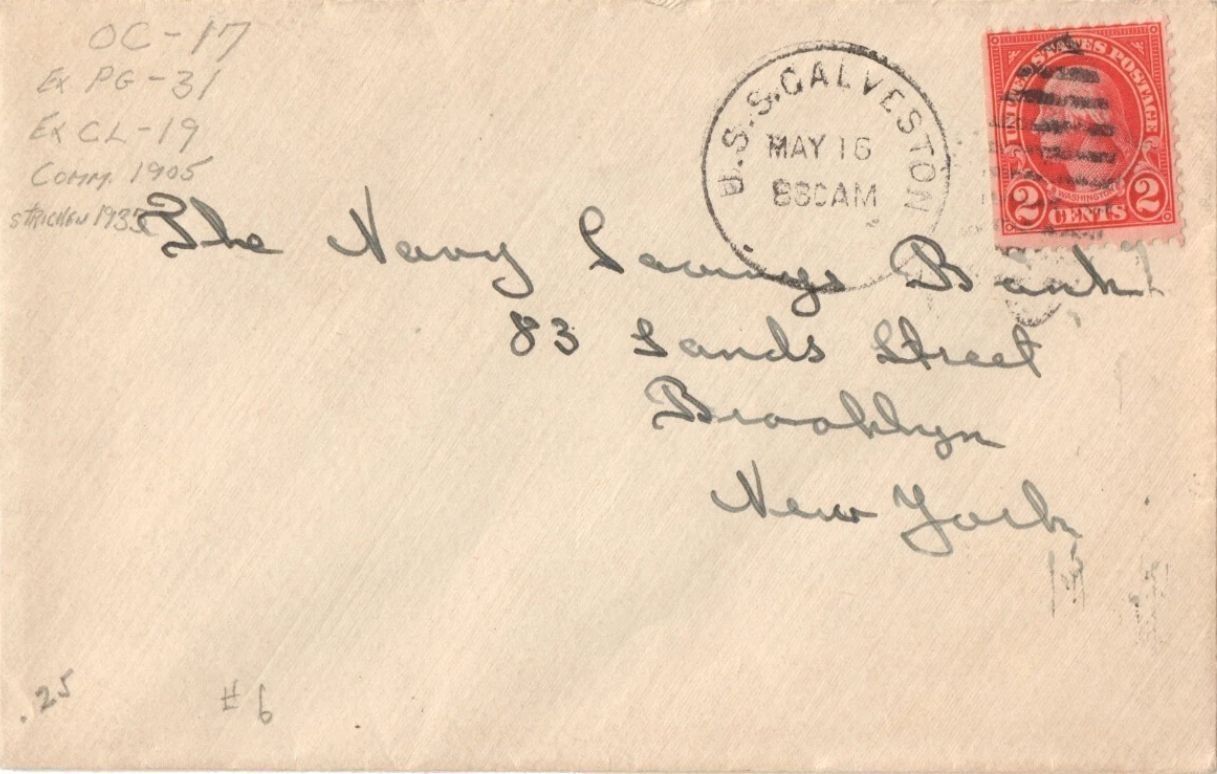Name/Title
USS Galveston (CL 19) “Navy Savings Bank” [Cover]Description
Cover recognized posted aboard USS Galveston between May 16, 1927-1929. Addressed to “The Navy Savings Bank / 83 Sands Street / Brooklyn / New York.”Context
Have you ever heard someone say, “He spends money like a drunken sailor”? This may be true for some sailors, but a sizable group was adding to their savings accounts at the Navy Savings Bank, 83 Sands Street, Brooklyn, N. Y. from 1920 to 8 September 1930, when this small bank merged with the much larger Dime Bank of Brooklyn. At the time of the merger, the assets of the Navy Savings Bank were $1,500,476.
When the worldwide economic depression started in the fall of 1929, all bank investments and savings accounts suffered great losses in the crash. The depositors of many banks lost everything, but after the merger, the assets of the Navy Savings Banks in 1930 returned 85% of the monies deposited. This was a bank-bymail operation with most of the depositors from the enlisted ranks. During the period of the bank’s operation, the pay rate for first enlistees varied between $21 and $24 per mo nth plus a onetime clothing allowance of $88. Most accounts were less than $1,000. The mail-in deposits were from all active ships and shore stations of the Navy. The vast number of navy covers saved from this operation was due to one navy cover collector: Charles Sumner Williams, Jr.
Williams studied at MIT but graduated from Harvard in 1917. He later became chairman of the Thomas A. Edison Company. Williams started amassing covers in 1923 and continued through the life of the bank. His continued access to these covers was through the position of his father, Rear Admiral Charles Sumner Williams, Supply Corps. Admiral Williams graduated from the USNA in July 1880 with the rank of Paymaster Ensign. He served at sea for several years as paymaster, and after the Spanish American War was appointed as the general storekeeper at the Norfolk, Virginia, Navy Yard. During and after World War I, he was CO of the Fleet Supply Base in New York City, where the Navy Savings Bank was formed. Admiral Williams owned the building at 83 Sands Street, where that bank was located. It is probable that Admiral Williams, as CO Fleet Supply Base and landlord of the bank’s office, was also on the Board of Directors of the bank.
Admiral Williams retired from active duty as a Commodore in 1920 but remained in the Navy Reserves. His Reserve rank was Rear Admiral. He died in 1936. There was some speculation originally that it was the Admiral who was the cover collector, but after all correspondence was reviewed, it was concluded that his son, Charles S. Williams, Jr. was the actual collector. Charles Williams, Jr., became interested as a navy cover collector around 1923 and over the years accumulated around 30,000 navy postmarks.
Williams’ collection numbered over 30,000 postmarks and was stored in five large 2 ft. x 3 ft. notebooks.
At first, these cancels were on cut squares and later on the entire envelope. He experimented with a system of classification of postmarks and had an extensive correspondence with Dr. Francis Locy. His collection was stored in five large 2 ft. x 3 ft. notebooks. After his death, these were sold by his sister to Frank Hoak and Jim Johnson.
